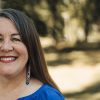My parents were the first people in my life who sparked a love for books and reading. My dad read to me when I was a child, and my mom would take me and my sister to the library regularly, letting me check out as many books as I could carry home. My mom also saved all the stories that I wrote from the time I was six years old. But I don’t think I would be a published children’s author today if not for the teachers who fostered my love for reading and writing along the way.
While I loved books from the moment I could read, it was my third-grade teacher, Miss Morris, who truly turned me into a reader. I can still recall the reading corner in her classroom, complete with shelves of books and a rocking chair. It was there I read Charlotte’s Web and all the Ruth Chew magic and witch books for the first time.
My fourth-grade teacher, Mrs. Shinohara, made me believe that I was good at writing stories. Many of her assignments had to do with creative writing and we had a class newspaper. I wrote and illustrated short stories (mostly about a dog named Fluffy). She praised my work and that only fueled my desire to write more stories. We got back in touch when I was starting to pursue publication. She encouraged me then, too. I only wish she had lived to see the day my books were published.
In retrospect, I wonder if I wrote those stories about Fluffy because I didn’t see any characters in books that looked like me and lived a similar life. I am a third-generation Japanese American and I grew up in Los Angeles with a large Japanese American community. Most of the books I read were either contemporary fiction focusing on friendship and family (all the books by Judy Blume) or fantasy/sci-fi like A Wrinkle in Time and The Lion, the Witch, and the Wardrobe. I loved those books, but they never featured kids with my background.
When I was in high school, I kept writing short stories for myself. They were mostly romance, and always with Japanese American main characters. And although I majored in zoology in college, I minored in English so I could keep indulging my writing habit. My creative writing teacher encouraged me to submit my stories to journals, and an English professor even wrote me a letter one summer to tell me I was in the wrong major and should switch to English. I didn’t follow through on either, but I kept those words of encouragement close to my heart.
It took me a long time to find the courage to pursue writing books for young people. After many drafts of many stories, hundreds of rejections, and years of learning the craft and the business of children’s publishing, I finally did it. Today I have written chapter book series, middle grade novels, and a picture book biography. Most of these books feature Japanese American characters, living a similar life to my own. They deal with friends and family, and in my middle grade books, first crushes.
This September, my twentieth book, Sweet and Sour (Scholastic), will be published. This story was conceived of and written during the COVID-19 pandemic, when the world was still sheltering-in-place. Writing this book was my escape. Every day I looked forward to sinking into Mai’s world where her biggest worry was whether or not she could ever forgive her childhood best friend, Zach, for an epic betrayal that totally humiliated her. For the first time, I set a story in the place I currently live—Mystic, Connecticut—with all its quaint, small-town atmosphere and summertime magic. I sprinkled in my own passions—birding, raptors, BTS—and the shops and restaurants I frequent in town and dearly missed visiting. Like Mai, I know very well what it’s like to be angry at a good friend, to have misunderstood motivations, and to grieve that loss. I wanted to write a sweet romance that doesn’t shy away from the most complicated nuances of friendship or the prejudice that Asian and Asian American kids face, which has only increased since the onset of the pandemic. Sweet and Sour is truly a book of my heart and I’m excited for readers to meet Mai Hirano and Zach Koyama.
But I can’t get this book into their hands alone. Educators play an important role in their students’ lives, providing all kinds of books for them—the ones where students can see themselves, and also the ones that give them a window into the hearts and minds of people who may not look like them, and who may have different backgrounds and traditions. But ultimately, they share the same emotions and fears and desires and joys. My road to publication has been both sweet and sour, but I will never forget Miss Morris, Mrs. Shinohara, and all the other wonderful educators who encouraged, inspired, and motivated me along the way.






